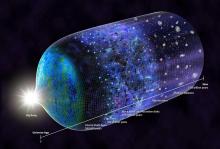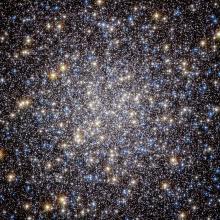Listen to today's episode of StarDate on the web the same day it airs in high-quality streaming audio without any extra ads or announcements. Choose a $8 one-month pass, or listen every day for a year for just $30.
You are here
Age of the Milky Way
Our home galaxy, the Milky Way, is ancient. It was born perhaps 13.6 billion years ago — just a couple of hundred million years after the Big Bang. And it’s been growing and changing ever since.
The Milky Way doesn’t have a birth certificate, so astronomers have to estimate its age. They do so mainly by measuring the ages of its stars.
Stars of different ages have slightly different chemical compositions. The oldest stars have relatively small amounts of anything other than hydrogen and helium — elements created in the Big Bang. The amounts of those heavier elements act as a sort of clock, allowing astronomers to figure out when a star was born.
Astronomers also use the “dead” stars known as white dwarfs — the bare cores of once-normal stars. A white dwarf is quite hot when it’s born, but it cools off at a known rate. So measuring a white dwarf’s temperature reveals how long it’s been cooling off — and hence its age.
Using these and other techniques, astronomers have found that the oldest stars in the Milky Way are more than 13 billion years old. But not all parts of the Milky Way are the same age; more about that tomorrow.
In the meantime, if you have dark skies, look for the glowing outline of the Milky Way standing high in the sky this evening. After night falls, it arcs from Aquila, the eagle, in the west-southwest; to Cygnus, the swan, high in the west; to W-shaped Cassiopeia in the northeast.
Script by Damond Benningfield






